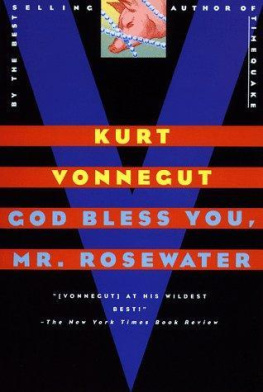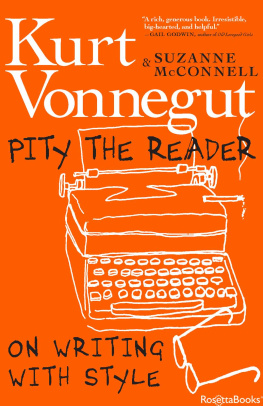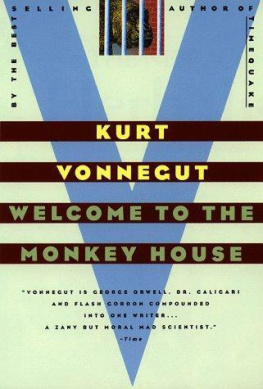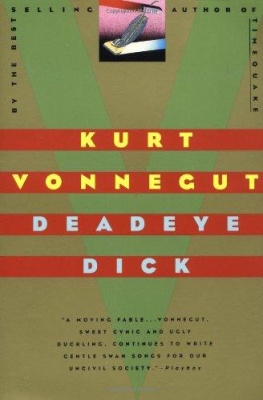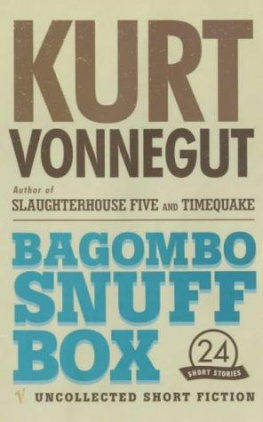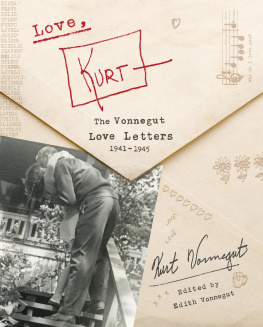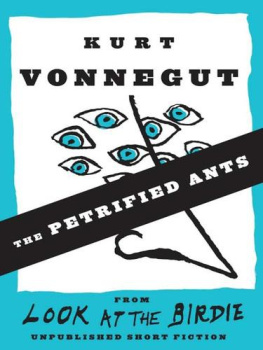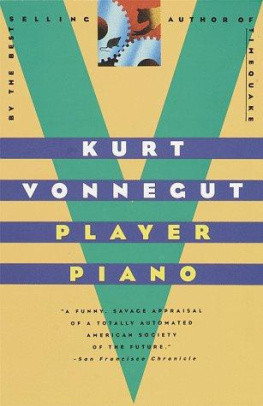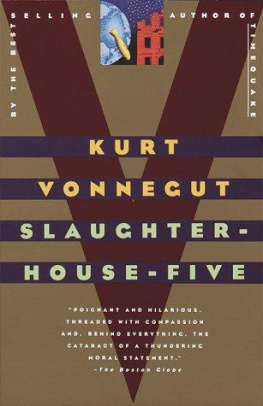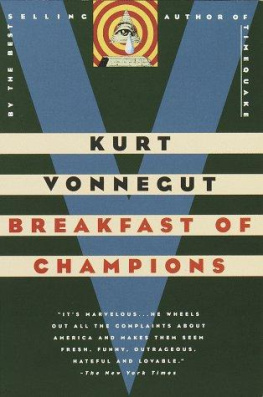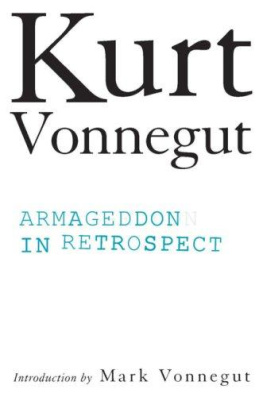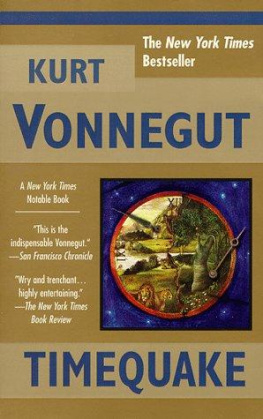Kurt Vonnegut - The Last Interview: And Other Conversations
Here you can read online Kurt Vonnegut - The Last Interview: And Other Conversations full text of the book (entire story) in english for free. Download pdf and epub, get meaning, cover and reviews about this ebook. year: 2011, publisher: Melville House, genre: Art. Description of the work, (preface) as well as reviews are available. Best literature library LitArk.com created for fans of good reading and offers a wide selection of genres:
Romance novel
Science fiction
Adventure
Detective
Science
History
Home and family
Prose
Art
Politics
Computer
Non-fiction
Religion
Business
Children
Humor
Choose a favorite category and find really read worthwhile books. Enjoy immersion in the world of imagination, feel the emotions of the characters or learn something new for yourself, make an fascinating discovery.

- Book:The Last Interview: And Other Conversations
- Author:
- Publisher:Melville House
- Genre:
- Year:2011
- Rating:5 / 5
- Favourites:Add to favourites
- Your mark:
- 100
- 1
- 2
- 3
- 4
- 5
The Last Interview: And Other Conversations: summary, description and annotation
We offer to read an annotation, description, summary or preface (depends on what the author of the book "The Last Interview: And Other Conversations" wrote himself). If you haven't found the necessary information about the book — write in the comments, we will try to find it.
The Last Interview: And Other Conversations — read online for free the complete book (whole text) full work
Below is the text of the book, divided by pages. System saving the place of the last page read, allows you to conveniently read the book "The Last Interview: And Other Conversations" online for free, without having to search again every time where you left off. Put a bookmark, and you can go to the page where you finished reading at any time.
Font size:
Interval:
Bookmark:
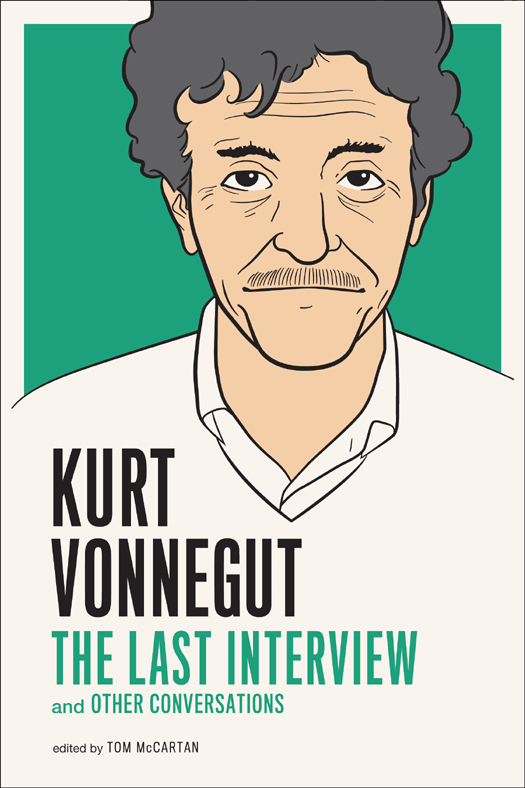
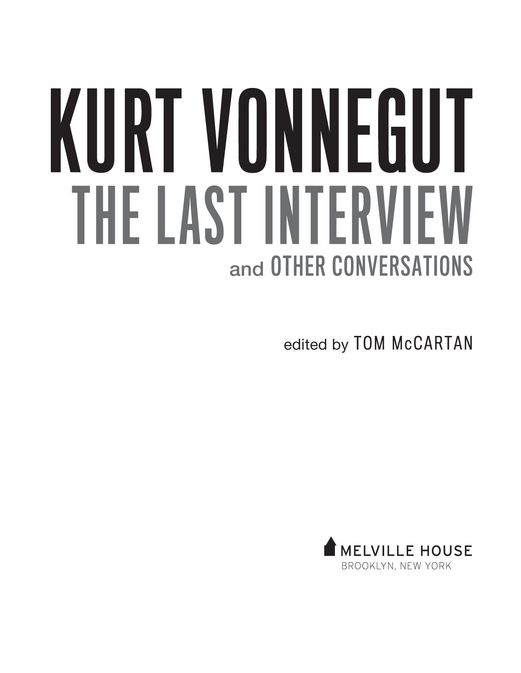
KURT VONNEGUT: THE LAST INTERVIEW
2011 Melville House Publishing
Kurt Vonnegut: The Art of Fiction 1977, The Paris Review and reprinted by arrangement with The Wylie Agency LLC.
There Must Be More to Love Than Death reprinted with permission from the August 2, 1980 issue of The Nation. For subscription information, call 1-800-333-8536. Portions of each weeks Nation magazine can be accessed at thenation.com
The Joe & Kurt Show 1992, Carole Mallory.
Originally appeared in Playboy magazine.
God Bless You, Mr. Vonnegut 2007, 2012, Project 13 Productions.
The Melancholia of Everything Completed reprinted by permission of by J.C. Gabel and Stop Smiling.
The Last Interview reprinted by permission of In These Times: inthesetimes.com
Melville House Publishing
145 Plymouth Street
Brooklyn, NY 11201
www.mhpbooks.com
eISBN: 978-1-61219-091-4
A catalog record for this book is available from the Library of Congress
Interviewed by David Hayman, David Michaelis,
George Plimpton, Richard Rhodes
The Paris Review
Spring 1977
Interview by Robert K. Musil
The Nation
August 1980
A Conversation with Kurt Vonnegut and Joseph Heller
With Carole Mallory
Playboy
May 1992
Interview by J.C. Gabel
Stop Smiling
August 2006
Interview by J. Rentilly
U.S. Airways Magazine
June 2007
Interview by Heather Augustyn
In These Times online
May 9, 2007
The last interview referred to in the title of this volume is in fact Kurt Vonneguts last published conversation, an interview conducted on February 28, 2007, by Heather Augustyn and published online May 9, 2007, by In These Times magazine, where Vonnegut himself often wrote. Also included here is J. Rentillys June 2007 U.S. Airways Magazine interview, which contains quotes from a conversation between Rentilly and Vonnegut that came after Augustyns interview. Rentillys interview draws on four conversations he had with Vonnegut between October 2000 and March 6, 2007, one month before Vonneguts passing at age 84.
THE ART OF FICTION
GEORGE PLIMPTON, RICHARD RHODES
FIRST PUBLISHED INTHE PARIS REVIEW,
NO. 69, SPRING 1977
This interview with Kurt Vonnegut was originally a composite of four interviews done with the author over the past decade. The composite has gone through an extensive working over by the subject himself, who looks upon his own spoken words on the page with considerable misgiving indeed, what follows can be considered an interview conducted with himself, by himself.
The introduction to the first of the incorporated interviews (done in West Barnstable, Massachusetts, when Vonnegut was forty-four) reads: He is a veteran and a family man, large-boned, loose-jointed, at ease. He camps in an armchair in a shaggy tweed jacket, Cambridge gray flannels, a blue Brooks Brothers shirt, slouched down, his hands stuffed into his pockets. He shells the interview with explosive coughs and sneezes, windages of an autumn cold and a lifetime of heavy cigarette smoking. His voice is a resonant baritone, Midwestern, wry in its inflections. From time to time he issues the open, alert smile of a man who has seen and reserved within himself almost everything: depression, war, the possibility of violent death, the inanities of corporate public relations, six children, an irregular income, long-delayed recognition.
The last of the interviews that made up the composite was conducted during the summer of 1976, years after the first. The description of him at this time reads: he moves with the low-keyed amiability of an old family dog. In general, his appearance is tousled: the long curly hair, mustache, and sympathetic smile suggest a man at once amused and saddened by the world around him. He has rented the Gerald Murphy house for the summer. He works in the little bedroom at the end of a hall where Murphy, artist, bon vivant, and friend to the artistic great, died in 1964. From his desk Vonnegut can look out onto the front lawn through a small window; behind him is a large, white canopy bed. On the desk next to the typewriter is a copy of Andy Warhols Interview, Clancy Sigals Zone of the Interior, and several discarded cigarette packs.
Vonnegut has chain-smoked Pall Malls since 1936 and during the course of the interview he smokes the better part of one pack. His voice is low and gravelly, and as he speaks, the incessant procedure of lighting the cigarettes and exhaling smoke is like punctuation in his conversation. Other distractions, such as the jangle of the telephone and the barking of a small, shaggy dog named Pumpkin, do not detract from Vonneguts good-natured disposition. Indeed, as Dan Wakefield once said of his fellow Shortridge High School alumnus, He laughed a lot and was kind to everyone.
INTERVIEWER
You are a veteran of the Second World War?
VONNEGUT
Yes. I want a military funeral when I diethe bugler, the flag on the casket, the ceremonial firing squad, the hallowed ground.
INTERVIEWER
Why?
VONNEGUT
It will be a way of achieving what Ive always wanted more than anythingsomething I could have had, if only Id managed to get myself killed in the war.
INTERVIEWER
Which is?
VONNEGUT
The unqualified approval of my community.
INTERVIEWER
You dont feel that you have that now?
VONNEGUT
My relatives say that they are glad Im rich, but that they simply cannot read me.
INTERVIEWER
You were an infantry battalion scout in the war?
VONNEGUT
Yes, but I took my basic training on the 240-millimeter howitzer.
INTERVIEWER
A rather large weapon.
VONNEGUT
The largest mobile fieldpiece in the army at that time. This weapon came in six pieces, each piece dragged wallowingly by a Caterpillar tractor. Whenever we were told to fire it, we had to build it first. We practically had to invent it. We lowered one piece on top of another, using cranes and jacks. The shell itself was about nine and a half inches in diameter and weighed three hundred pounds. We constructed a miniature railway which would allow us to deliver the shell from the ground to the breech, which was about eight feet above grade. The breechblock was like the door on the vault of a savings and loan association in Peru, Indiana, say.
INTERVIEWER
It must have been a thrill to fire such a weapon.
VONNEGUT
Not really. We would put the shell in there, and then we would throw in bags of very slow and patient explosives. They were damp dog biscuits, I think. We would close the breech, and then trip a hammer which hit a fulminate of mercury percussion cap, which spit fire at the damp dog biscuits. The main idea, I think, was to generate steam. After a while, we could hear these cooking sounds. It was a lot like cooking a turkey. In utter safety, I think, we could have opened the breechblock from time to time, and basted the shell. Eventually, though, the howitzer always got restless. And finally it would heave back on its recoil mechanism, and it would have to expectorate the shell. The shell would come floating out like the Goodyear blimp. If we had had a stepladder, we could have painted Fuck Hitler on the shell as it left the gun. Helicopters could have taken after it and shot it down.
Font size:
Interval:
Bookmark:
Similar books «The Last Interview: And Other Conversations»
Look at similar books to The Last Interview: And Other Conversations. We have selected literature similar in name and meaning in the hope of providing readers with more options to find new, interesting, not yet read works.
Discussion, reviews of the book The Last Interview: And Other Conversations and just readers' own opinions. Leave your comments, write what you think about the work, its meaning or the main characters. Specify what exactly you liked and what you didn't like, and why you think so.

